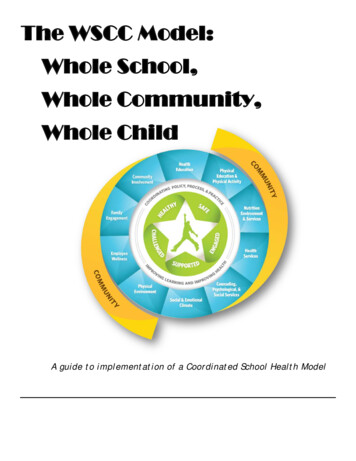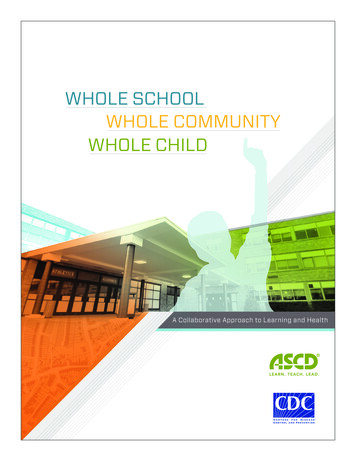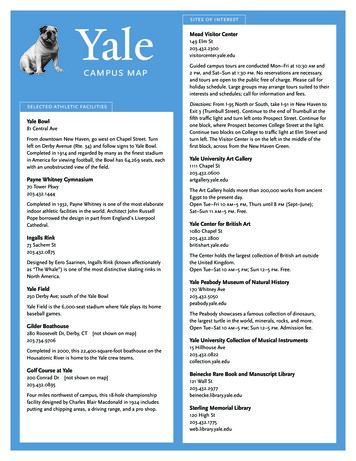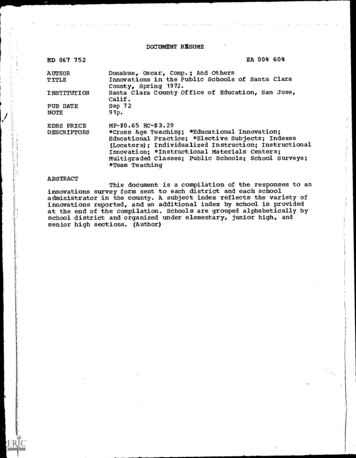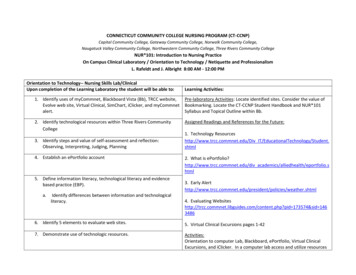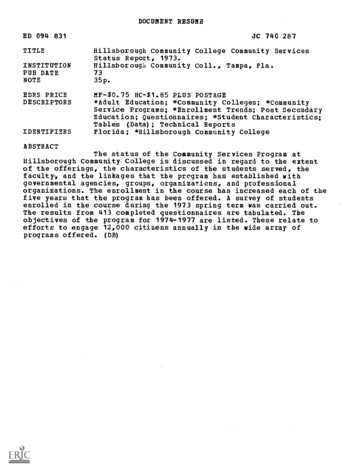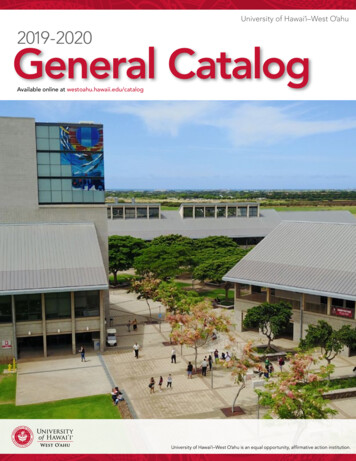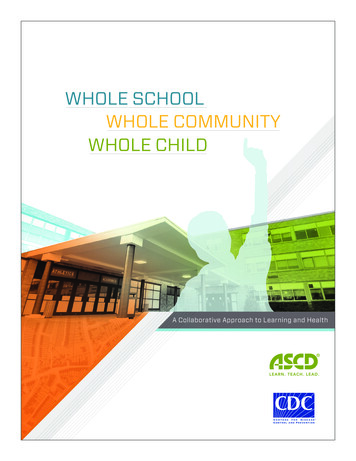
Transcription
WHOLE SCHOOLWHOLE COMMUNITYWHOLE CHILDA Collaborative Approach to Learning and Health
1703 North Beauregard St. Alexandria, VA 22311-1714 USAPhone: 1-800-933-2723 or 1-703-578-9600 Fax: 1-703-575-5400Website:www.ascd.org E-mail: wholechild@ascd.orgGene R. Carter, Executive Director; Judy Seltz, Deputy Executive Director, Chief Constituent Services Officer; SeanSlade, Director, Whole Child Programs; Theresa Lewallen, Senior Director, Constituent Programs; Klea Scharberg,Whole Child Programs Specialist; Kristen Pekarek, Project Coordinator; Gary Bloom, Senior Creator Director; ReeceQuiñones, Art Director; Lindsey Heyl Smith, Graphic Designer; Greer Wymond, Graphic Designer; Mary Beth Nielsen,Manager, Editorial Services; Mike Kalyan, Manager, Production Services; Kyle Steichen, Production Specialist 2014 by ASCD. All rights reserved. Printed in the United States of America.ABOUT ASCDASCD is a global community dedicated to excellence in learning, teaching, and leading. Comprising 140,000 members—superintendents, principals, teachers, and advocates from more than 138 countries—the ASCD communityalso includes 56 affiliate organizations. ASCD’s innovative solutions promote the success of each child. To learn moreabout how ASCD supports educators as they learn, teach, and lead, visit www.ascd.org.ABOUT ASCD’S WHOLE CHILD INITIATIVELaunched in 2007, ASCD’s Whole Child Initiative is an effort to change the conversation about education froma focus on narrowly defined academic achievement to one that promotes the long-term development and success ofchildren. Through the initiative, ASCD helps educators, families, community members, and policymakers move froma vision about educating the whole child to sustainable, collaborative action. ASCD is joined in this effort by WholeChild Partner organizations representing the education, arts, health, policy, and community sectors. Learn more atwww.ascd.org/wholechild.ABOUT THE U.S. CENTERS FOR DISEASE CONTROL AND PREVENTIONCDC works 24/7 to protect America from health, safety, and security threats, both foreign and in the U.S. Whetherdiseases start at home or abroad, are chronic or acute, curable or preventable, human error or deliberate attack, CDCfights disease and supports communities and citizens to do the same. As the nation’s health protection agency, CDCsaves lives and protects people from health threats. To accomplish its mission, CDC conducts critical science and provides health information that protects our nation against expensive and dangerous health threats, and responds whenthese arise. Learn more at www.cdc.gov.The mark ‘CDC’ is owned by the U.S. Dept. of Health and Human Services and is used with permission. Use of this logo is not anendorsement by HHS or CDC of any particular product, service, or enterprise.
WHOLE SCHOOLWHOLE COMMUNITYWHOLE CHILDA Collaborative Approach to Learning and Health03Why We Need a Collaborative Approach to Learning and Health05The Need for a New Model06Expanded Components09Coordinating Policy, Process, and Practice09Whole School, Whole Community, Whole Child10References12Core and Consultation Groups13The Whole School, Whole Community, Whole Child Model
HEALTH AND EDUCATIONAFFECT INDIVIDUALS,SOCIETY, AND THEECONOMY AND, AS SUCH,MUST WORK TOGETHERWHENEVER POSSIBLE.SCHOOLS ARE A PERFECTSETTING FOR THISCOLLABORATION.
WHY WE NEED A COLLABORATIVE APPROACHTO LEARNING AND HEALTHHealth and well-being have, for too long, been putinto silos—separated both logistically and philosophically from education and learning.youth attend school. At the same time, integrating health services and programs more deeplyinto the day-to-day life of schools and studentsrepresents an untapped tool for raising academicachievement and improving learning.In his meta-analysis Healthier Students Are Better Learners,1 Charles Basch called a renewedfocus on health the missing link in school reformsto close the achievement gap.In short, learning and health are interrelated.Studies demonstrate that when children’sbasic nutritional and fitness needs are met,they attain higher achievement levels.2–14Similarly, the use of school-based and schoollinked health centers ensuring access to neededphysical, mental, and oral health care improvesattendance,15 behavior,16–21 and achievement.22–25The development of connected and supportiveschool environments benefits teaching andlearning, engages students, and enhances positiveNo matter how well teachers are prepared toteach, no matter what accountability measures are put in place, no matter what governing structures are established for schools,educational progress will be profoundly limited if students are not motivated and ableto learn.Yet in the same publication Basch stated,Though rhetorical support is increasing,school health is currently not a central part ofthe fundamental mission of schools in America nor has it been well integrated into thebroader national strategy to reduce the gapsin educational opportunity and outcomes.For the purposes of this document, academicachievement is defined as:1. Academic performance (class grades,standardized tests, and graduation rates);2. Education behavior (attendance, dropoutrates, and behavioral problems at school);andHealth and education affect individuals, society,and the economy and, as such, must work togetherwhenever possible. Schools are a perfect setting for this collaboration. Schools are one of themost efficient systems for reaching children andyouth to provide health services and programs, asapproximately 95 percent of all U.S. children and3. Students’ cognitive skills and attitudes(concentration, memory, and mood).Source: Centers for Disease Control and Prevention. The associationbetween schoolbased physical activity, including physical education,and academic performance. Atlanta (GA): US Department of Healthand Human Services; 2010.3
It is time to truly align the sectors and place the child atthe center. Both public health and education serve thesame students, often in the same settings. We must domore to work together and collaborate.—WAYNE H. GILES, DIRECTOR, DIVISION OF POPULATION HEALTH,NATIONAL CENTER FOR CHRONIC DISEASEPREVENTION AND HEALTH PROMOTION, CDC4
learning outcomes. The development of a positivesocial and emotional climate increases academicachievement, reduces stress, and improvespositive attitudes toward self and others.26, 27whole child. Policy, practice, and resourcesmust be aligned to support not only academiclearning for each child, but also the experiencesthat encourage development of a whole child—one who is knowledgeable, healthy, motivated,and engaged.42In turn, academic achievement is an excellentindicator for the overall well-being of youth anda primary predictor and determinant of adulthealth outcomes.28–29 Individuals with more education are likely to live longer; experience betterhealth outcomes; and practice health-promotingbehaviors such as exercising regularly, refraining from smoking, and obtaining timely healthcare check-ups and screenings.32–34 These positive outcomes are why many of the nation’s leading educational organizations recognize the closerelationship between health35–37 and education, aswell as the need to foster health and well-beingwithin the educational environment for all students.38–41Similar calls for collaboration have come fromthe health sector, including the U. S. Centers forDisease Control and Prevention (CDC).In sum, if American schools do not coordinateand modernize their school health programsas a critical part of educational reform, ourchildren will continue to benefit at the margins from a wide disarray of otherwise unrelated, if not underdeveloped, efforts to improveinterdependent education, health, and socialoutcomes. And, we will forfeit one of the mostappropriate and powerful means available toimprove student performance.43THE NEED FOR A NEW MODELThe traditional coordinated school health (CSH)approach has been a mainstay of school healthin the United States since 1987. Promulgated bythe CDC, the CSH approach has provided a succinct and distinct framework for organizing a comprehensive approach to school health. In additionto the CDC, many national health and educationorganizations have supported the CSH approach.However, it has been viewed by educators asprimarily a health initiative focused only onhealth outcomes and has consequently gainedlimited traction across the education sector at theschool level.In 2007, ASCD called for an acknowledgement ofthe interdependent nature of health and learning.We call on communities—educators, parents,businesses, health and social service providers,arts professionals, recreation leaders, and policymakers at all levels—to forge a new compactwith our young people to ensure their wholeand healthy development. We ask communities to redefine learning to focus on the wholeperson. We ask schools and communities tolay aside perennial battles for resources andinstead align those resources in support of the5
ASCD’s Whole Child Initiative is an effort tochange the conversation about education from afocus on narrowly defined academic achievementto one that promotes the long-term developmentand success of the whole child. Through the initiative, ASCD helps educators, families, communitymembers, and policymakers move from a visionabout educating the whole child to sustainable,collaborative action. However, this approach hasbeen viewed primarily as an education initiativeand has gained limited traction with the healthcommunity.The focus of the WSCC model is an ecologicalapproach that is directed at the whole school,with the school in turn drawing its resourcesand influences from the whole communityand serving to address the needs of the wholechild. ASCD and the CDC encourage use ofthe model as a framework for improvingstudents’ learning and health in our nation’sschools.EXPANDED COMPONENTSWhereas the traditional CSH approach contained eight components, this model contains 10,expanding the original components of Healthyand Safe School Environment and Family andCommunity Involvement into four distinctcomponents. The expansion focuses additional attention on the effect of the Social andEmotional Climate in addition to the PhysicalEnvironment. Family and community involvement is divided into two separate componentsto emphasize the role of community agencies,businesses, and organizations as well as thecritical role of Family Engagement. This changemarks the need for greater emphasis on both thepsychosocial and physical environments as wellas the ever-expanding roles that communityagencies and families must play. Finally, thisnew model also addresses the need to engagestudents as active participants in their learningand health.The Whole School, Whole Community, WholeChild (WSCC) model combines and builds onelements of the traditional coordinated schoolhealth approach and the whole child framework.ASCD and the CDC developed this new model—in collaboration with key leaders from the fieldsof health, public health, education, and schoolhealth—to strengthen a unified and collaborativeapproach to learning and health.The new model responds to the call for greateralignment, integration, and collaborationbetween education and health to improve eachchild’s cognitive, physical, social, and emotionaldevelopment. It incorporates the components ofa coordinated school health program around thetenets of a whole child approach to educationand provides a framework to address the symbiotic relationship between learning and health.6
THE WSCC MODEL RESPONDS TOTHE CALL FOR GREATER ALIGNMENT,INTEGRATION, AND COLLABORATIONBETWEEN HEALTH AND EDUCATIONTO IMPROVE EACH CHILD’S COGNITIVE,PHYSICAL, SOCIAL, AND EMOTIONALDEVELOPMENT.7
The Whole School, Whole Community,Whole Child model developed by ASCD andthe CDC takes the call for greater collaborationover the years and puts it firmly in place.For too long, entities have talked aboutcollaboration without taking the necessarysteps. This model puts the process into action.—DR. GENE R. CARTER, CEO & EXECUTIVE DIRECTOR, ASCD8
COORDINATING POLICY,PROCESS, AND PRACTICEject or sector. Rather than being an initiativeowned by one teacher, one nurse, department orprofession, this model outlines the whole schoolapproach, with every adult and every studentplaying a role in the growth and development ofself, peers, and the school overall.The key to moving from model to action is collaborative development of local school policies, processes,and practices. The day-to-day practices within eachsector require examination and collaboration sothat they work in tandem, with appropriate complementary processes guiding each decision andaction. Developing joint and collaborative policy ishalf the challenge; putting it into action and makingit routine completes the task.Just as the whole school plays its part, the newmodel outlines how the school, staff, and studentsare placed within the local community. While theschool may be a hub, it remains a focal reflectionof its community and requires community input,resources, and collaboration in order to supportits students. As with any relationship this worksboth ways. Community strengths can boost therole and potential of the school, but areas of needin the community also become reflected in theschool, and as such must be addressed.To develop joint or collaborative policies, processes, and practices, all parties involved shouldstart with a common understanding about theinterrelatedness of learning and health. Fromthis understanding, current and future systemsand actions can be adjusted, adapted, or crafted tojointly achieve both learning and health outcomes.Each child, in each school, in each of our communities deserves to be healthy, safe, engaged,supported, and challenged. That’s what a wholechild approach to learning, teaching, and community engagement really is about. More thanmerely a way to boost achievement or academics,the whole child approach views the collaborationbetween learning and health as fundamental. Thedevelopment of the whole child is more than theacquisition of knowledge or skills, behavior orcharacter; it is all of these.WHOLE SCHOOL, WHOLECOMMUNITY, WHOLE CHILDThe new model redirects attention onto theultimate focus of the two sectors—the child. Itemphasizes a schoolwide approach rather thanone that is subject- or location-specific, and itacknowledges the position of learning, health,and the school as all being a part, and reflection,of the local community.The new model calls for a greater collaborationacross the community, across the school, andacross sectors to meet the needs and reach thepotential of each child.The efforts to address the educational and healthneeds of youth should be seen as a schoolwideendeavor as opposed to being confined to a sub-9
REFERENCES1. Basch CE. Healthier Students Are Better Learners:A Missing Link in School Reforms to Closethe Achievement Gap. Columbia University;2010. http://www.equitycampaign.org/i/a/document/12557 EquityMattersVol6Web03082010.pdf. Accessed April 29, 2014.12. Taras H. Physical activity and student performance.Journal of School Health 2005; 75(6): 214–8.13. Trudeau F, Shepard RJ Physical education, schoolphysical activity, sports and academic performance.International Journal of Behavioral Nutrition andPhysical Activity 2008; 5: 10.2. Bradley B, Green AC. Do health and education agencies in the United States share responsibility for academic achievement and health? A review of 25 yearsof evidence about the relationship of adolescents’academic achievement and health behaviors. Journal of Adolescent Health May 2013; 52(5): 523–32.14. Centers for Disease Control and Prevention. A Guidefor Developing Comprehensive School PhysicalActivity Programs. Atlanta (GA): US Department ofHealth and Human Services; 2013.15. Centers for Disease Control and Prevention. SchoolConnectedness: Strategies for Increasing ProtectiveFactors Among Youth. Atlanta (GA): US Departmentof Health and Human Services; 2009.3. Murphy JM, Pagano ME, Nachmani J, Sperling P,Kane S, Kleinman RE. The relationship of schoolbreakfast to psychosocial and academic functioning. Archives of Pediatrics and Adolescent Medicine1998; 152(9): 899–907.16. Centers for Disease Control and Prevention. Parent Engagement: Strategies for Involving Parentsin School Health. Atlanta (GA): US Department ofHealth and Human Services; 2012.4. Rampersaud GC, Pereira MA, Girard BL, Adams J,Metzl JD. Breakfast habits, nutritional status, bodyweight, and academic performance in children andadolescents. Journal of the American Dietetic Association 2005; 105(5): 743–60, quiz 761–2.17. Byrk A, Sebrig PB, Allensworth EM, Luppesca S,Easton JQ. Organizing schools for improvement:Lessons from Chicago. Chicago (IL): University ofChicago Press; 2010. http://ccsr.uchicago.edu/books/osfi/prologue.pdf. Accessed April 29, 2014.5. Taras, H. Nutrition and student performanceat school. Journal of School Health 2005; 75(6):199–213.18. City Connects. The impact of city connects: Progressreport 2012. Boston: City Connects, Boston CollegeCenter for Optimized Student Support; 2013. ityconnects/pdf/CityConnects ProgressReport2012.pdf. Accessed April 29, 2014.6. Murphy JM. Breakfast and learning: an updatedreview. Current Nutrition & Food Science 2007;3: 3–36.7. Widenhorn-Müller K, Hille K, Klenk J, Weiland U.Influence of having breakfast on cognitive performance and mood in 13- to 20-year-old high schoolstudents: Results of a crossover trial. Pediatrics2008; 122(2): 279–84.19. ICF International. Communities in Schools NationalEvaluation Five Year Summary Report. Fairfax (VA):Author; 2010. attachments/CommunitiesIn Schools National Evaluation Five YearSummary Report.pdf. Accessed April 29, 2014.8. Alaimo K, Olson CM, Frongillo EA. Food insufficiency and American school-aged children’scognitive, academic, and psychosocial development.Pediatrics 2001; 108(1): 44–53.20. SOPHE/ASCD Expert Panel on Youth HealthDisparities. Reducing Youth Health DisparitiesRequires Cross-Agency Collaboration Between theHealth and Education Sectors. Washington (DC):SOPHE; 2013. http://www.sophe.org/SchoolHealth/Disparities.cfm. Accessed April 29, 2014.9. Student Health and Academic Achievement. Centersfor Disease Control and Prevention; 2009. http://www.cdc.gov/healthyyouth/health and academics/index.htm. Accessed April 29, 2014.10. Centers for Disease Control and Prevention. Theassociation between school-based physical activity,including physical education, and academic performance. Atlanta (GA): US Department of Health andHuman Services; 2010.21. Castrechini S, London RA. Positive StudentOutcomes in Community Schools. Washington(DC): Center for American Progress; 2012. /issues/2012/02/pdf/positive student outcomes.pdf. Accessed April 29, 2014.11. Fedewa AL, Ahn S. The effects of physical activityand physical fitness on children’s achievement andcognitive outcomes: a meta-analysis. Research Quarterly for Exercise & Sport 2011; 82(3): 521–35.22. Murray N, Franzini L, Marko D, Lupo P, Garza J,Linder S. Education and health: A review and assessment, Appendix E. Code Red: The Critical Conditionof Health in Texas 2006. http://www.coderedtexas.org/files/Appendix E.pdf. Accessed April 29, 2014.10
23. Steinberg MP, Allensworth EM, Johnson DW. Student and teacher safety in Chicago public schools:The roles of community context and school socialorganization. Chicago (IL): Consortium on ChicagoSchool Research; 2011. http://ccsr.uchicago.edu/downloads/8499safety in cps.pdf. Accessed April29, 2014.34. Healthy Schools Campaign. Health in Mind: Improving education through wellness. Washington (DC):Trust for America’s Health; 2012. althin Mind Report.pdf. Accessed April 29, 2014.35. Action for Healthy Kids. The Learning Connection: What you need to know to ensure your kids arehealthy and ready to learn. Chicago (IL): Author;2013. nts/pdfs/afhk thelearningconnectiondigitaledition.pdf. Accessed April 29, 2014.24. Dean S. Hearts and minds: A public school miracle.New York (NY): Penguin Canada; 2001.25. Cohen J, McCabe EM, Michelli NM, Pickeral T.School climate: Research, policy, teacher education and practice. Teachers College Record 2009;111(1): 180–213. http://www.tcrecord.org/Content.asp?ContentId 15220. Accessed April 29, 2014.36. GENYOUTH. The Wellness Impact: EnhancingAcademic achievement through Healthy SchoolEnvironments. New York (NY): Author; uploads/2013/02/The Wellness Impact Report.pdf. Accessed April 29, 2014.26. Durlak J, Weissberg RP, Dymnicki AB, Taylor RD,Schellinger KB. The impact of enhancing students’social and emotional learning: A meta-analysis ofschool based universal interventions. Child Development 2011; 82(1): 405–32.37. Council of Chief State School Officers. Policy Statement on School Health; 2004. http://www.ccsso.org/Resources/Publications/Policy Statement onSchool Health.html. Accessed April 29, 2014.27. Harper S, Lynch J. Trends in socioeconomic inequalities in adult health behaviors among US states,1990–2004. Public Health Reports 2007; 122(2):77–189.38. National School Boards Association. Beliefs andPolicies of the National School Boards Association.Alexandria (VA): Author; 2013. iefs%20%26%20Policies%20Text%20Format.pdf. Accessed April 29,2014.28. Vernez G, Krop RA, Rydell CP. Closing the educationgap: Benefits and costs. Santa Monica (CA): RANDCorporation; 1999.29. National Center for Health Statistics. Health, UnitedStates, 2012: With Special Feature on EmergencyCare. Hyattsville (MD): US Department of Healthand Human Services; 2013.39. American Association of School Administrators.Position statement 3: Getting children readyfor success in school, July 2006; Positionstatement 18: Providing a safe and nurturingenvironment for students, July /AASAPositionStatements072408.pdf.Accessed April 29, 2014.30. Educational and Community-Based Programs.HealthyPeople.gov; 2010. 2020/overview.aspx?topicid 11. Accessed April 29, 2014.31. Cutler D, Lleras-Muney A. Education and health:Evaluating theories and evidence. Bethesda (MD):National Bureau of Economic Research; 2006.40. ASCD. Making the Case for Educating the WholeChild. Alexandria (VA): Author; 2012. mx-resources/WholeChild-MakingTheCase.pdf.Accessed April 29, 2014.32. Braveman P, Egerter S. Overcoming obstacles tohealth: Report from the Robert Wood JohnsonFoundation to the Commission to Build a HealthierAmerica. Washington (DC): Robert Wood Johnson Foundation Commission to Build a HealthierAmerica; 2008. ealth-Report.pdf. AccessedApril 29, 2014.41. ASCD. The Learning Compact Redefined: A Call toAction. Alexandria (VA): Author; 2007. earning%20Compact.pdf. Accessed April 29, 2014.42. Kolbe L. Education reform and the goals of modernschool health programs. The State Education Standard 2002; 3(4): 4–11.33. Ross CE, Wu C. The links between educationand health. American Sociological Review1995; 60(5): 719–45.11
CONSULTATION GROUPDiane D. Allensworth, PhDProfessor Emeritus, Kent State UniversityCORE GROUPWayne Giles, MD, MSDirector, Division of Population Health,National Center for Chronic DiseasePrevention and Health Promotion,Centers for Disease Control and PreventionHolly Hunt, MABranch Chief, School Health Branch,Division of Population Health,National Center for Chronic DiseasePrevention and Health Promotion,Centers for Disease Control and PreventionTheresa C. Lewallen, MA, CHESSenior Director, Constituent ProgramsASCDWilliam Potts-Datema, MSActing Senior Advisor, Division of Adolescentand School Health, Centers for DiseaseControl and PreventionSean Slade, MEdDirector, Whole Child ProgramsASCDRobert Balfanz, PhDCo-Director of the Everyone Graduates Centerat the Center for Social Organization ofSchools, Johns Hopkins University’s Schoolof EducationCharles E. Basch, PhDRichard March Hoe Professor of Healthand Education, Teachers College,Columbia UniversityMark Ginsberg, PhDProfessor and Dean of the College ofEducation and Human Development,George Mason UniversityLloyd J. Kolbe, PhDEmeritus Professor of Applied Health Science,Indiana University School of Public Health—BloomingtonRichard A. Lyons, MASuperintendent of Schools,Maine Regional School Unit #22Laura Rooney, MPHAdolescent Health Program Manager,Ohio Department of HealthSusan K. Telljohann, HSD, CHESProfessor, Health Education, Departmentof Health and Recreation Professions,The University of Toledo12
WHOLE SCHOOLWHOLE COMMUNITYWHOLE CHILDA Collaborative Approach to Learning and Health13
For more information on the Whole School, Whole Child, WholeCommunity collaborative approach to learning and health, visitwww.ascd.org/learningandhealth.
ASCD's Whole Child Initiative is an effort to . change the conversation about education from a focus on narrowly defined academic achievement to one that promotes the long-term development and success of the whole child. Through the initia - tive, ASCD helps educators, families, community members, and policymakers move from a vision
